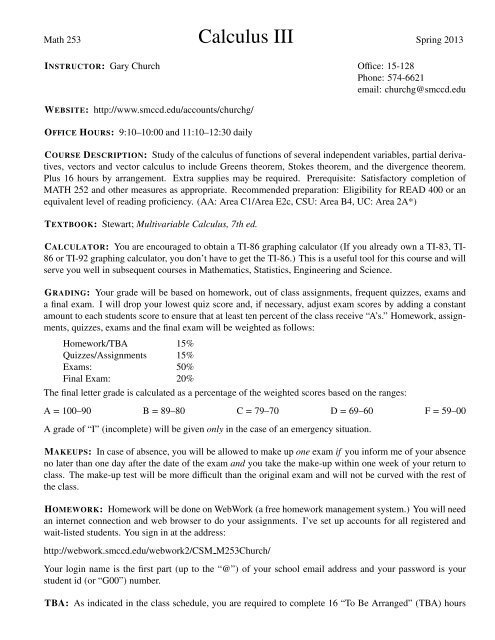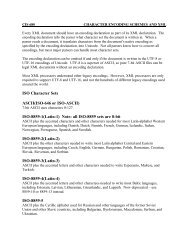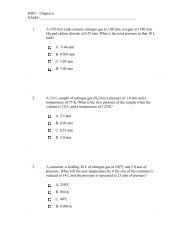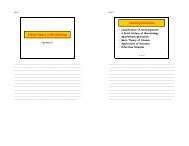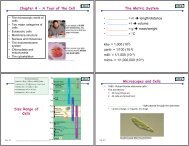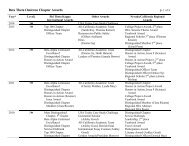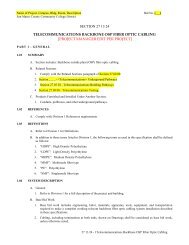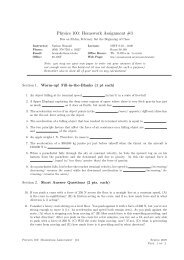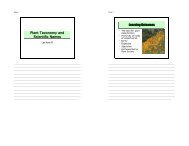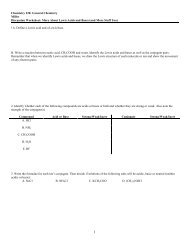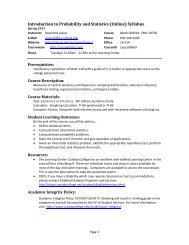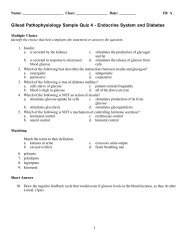Calculus III
Calculus III
Calculus III
Create successful ePaper yourself
Turn your PDF publications into a flip-book with our unique Google optimized e-Paper software.
Math 253 <strong>Calculus</strong> <strong>III</strong> Spring 2013<br />
INSTRUCTOR: Gary Church Office: 15-128<br />
Phone: 574-6621<br />
email: churchg@smccd.edu<br />
WEBSITE: http://www.smccd.edu/accounts/churchg/<br />
OFFICE HOURS: 9:10–10:00 and 11:10–12:30 daily<br />
COURSE DESCRIPTION: Study of the calculus of functions of several independent variables, partial derivatives,<br />
vectors and vector calculus to include Greens theorem, Stokes theorem, and the divergence theorem.<br />
Plus 16 hours by arrangement. Extra supplies may be required. Prerequisite: Satisfactory completion of<br />
MATH 252 and other measures as appropriate. Recommended preparation: Eligibility for READ 400 or an<br />
equivalent level of reading proficiency. (AA: Area C1/Area E2c, CSU: Area B4, UC: Area 2A*)<br />
TEXTBOOK: Stewart; Multivariable <strong>Calculus</strong>, 7th ed.<br />
CALCULATOR: You are encouraged to obtain a TI-86 graphing calculator (If you already own a TI-83, TI-<br />
86 or TI-92 graphing calculator, you don’t have to get the TI-86.) This is a useful tool for this course and will<br />
serve you well in subsequent courses in Mathematics, Statistics, Engineering and Science.<br />
GRADING: Your grade will be based on homework, out of class assignments, frequent quizzes, exams and<br />
a final exam. I will drop your lowest quiz score and, if necessary, adjust exam scores by adding a constant<br />
amount to each students score to ensure that at least ten percent of the class receive “A’s.” Homework, assignments,<br />
quizzes, exams and the final exam will be weighted as follows:<br />
Homework/TBA 15%<br />
Quizzes/Assignments 15%<br />
Exams: 50%<br />
Final Exam: 20%<br />
The final letter grade is calculated as a percentage of the weighted scores based on the ranges:<br />
A = 100–90 B = 89–80 C = 79–70 D = 69–60 F = 59–00<br />
A grade of “I” (incomplete) will be given only in the case of an emergency situation.<br />
MAKEUPS: In case of absence, you will be allowed to make up one exam if you inform me of your absence<br />
no later than one day after the date of the exam and you take the make-up within one week of your return to<br />
class. The make-up test will be more difficult than the original exam and will not be curved with the rest of<br />
the class.<br />
HOMEWORK: Homework will be done on WebWork (a free homework management system.) You will need<br />
an internet connection and web browser to do your assignments. I’ve set up accounts for all registered and<br />
wait-listed students. You sign in at the address:<br />
http://webwork.smccd.edu/webwork2/CSM M253Church/<br />
Your login name is the first part (up to the “@”) of your school email address and your password is your<br />
student id (or “G00”) number.<br />
TBA: As indicated in the class schedule, you are required to complete 16 “To Be Arranged” (TBA) hours
this semester. Each TBA is credited as a homework assignment. TBA hours can be completed by doing<br />
various activities which will be described throughout the semester.<br />
MRC: You are encouraged to go to the Math Resource Center (MRC) in 18-202 to study and get help on<br />
your homework and assignments. The MRC is staffed by student tutors and mathematics faculty eager to<br />
assist you. More information about the MRC can be found at: http://www.smccd.edu/accounts/csmmrc/<br />
DISABILITIES: If you have a documented disability and need accommodations for this class, please see me<br />
as soon as possible or contact the Disabled Students Programs and Services (DSPS) for assistance. The DSPS<br />
is located in the College Center (Bldg. 10) Room 120. (650) 574-6438; FAX (650) 574-6434<br />
• Confidentiality. Students with disabilities are protected under Family Education Rights and Privacy Act<br />
(FERPA). Please understand confidentiality and do not identify the person or their disability information<br />
to other students.<br />
• Taping Lecture. Students who are unable to take or read notes have the right to tape record class lectures<br />
only for their personal study.<br />
• Documentation. Students must provide documentation before they are entitled to accommodations. If<br />
you have any questions, please feel free to contact me or Audra Fernandez at (650) 574-6438; fernandeza@smccd.edu<br />
ATTENDANCE: Attendance, while not directly affecting your grade, is very important; there is a direct<br />
correlation between attendance and grade point average. Attendance will be recorded each class meeting<br />
and excessive absence (five or more days) is cause for being dropped from the course, regardless of academic<br />
progress. Whether a student is actually dropped depends on individual circumstances.<br />
FINAL EXAM: The final exam is comprehensive and will be given on Friday, May 24, 8:10–10:40 a.m..<br />
IMPORTANT DATES:<br />
• Last day to add or to drop with possible class fee refund: Mon., Jan. 28.<br />
• Last day to drop with no mention of course on transcript: Sun., Feb. 3.<br />
• Last day to drop with a guaranteed “W” grade: Thu., April 25.<br />
No “W” grades will be given after this date! Please bring me a drop slip if you decide to drop the class.<br />
STUDENT LEARNING OUTCOMES:<br />
Upon completion of this course, the student will be able to:<br />
1. Compute limits of functions of several variables, or show that the limits do not exist.<br />
2. Compute partial derivatives and directional derivatives.<br />
3. Solve extremum problems, using a) partial derivatives and b) Lagrange multipliers.<br />
4. Set up and evaluate multiple integrals, and use them in geometric and physical applications.<br />
5. Compute dot and cross products of vectors; use them to find equations of lines and planes in R3.<br />
6. Compute line and surface integrals.<br />
7. Use cylindrical and spherical coordinates, and parametric equations, to study functions of several variables<br />
and surfaces.<br />
8. Compute and apply the gradient of scalar functions, and the divergence and curl of vector fields.


